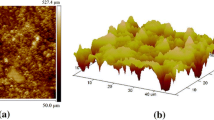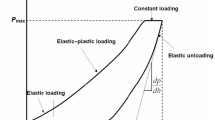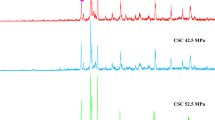Abstract
In this paper, the cement paste and the mortar were tested using the PF-QNM technique. It is shown that the PF-QNM technique is very powerful to characterize the mechanical properties of micro- and nanostructures in the cement-based materials. It does not have strict requirements for test environment and it does not damage the surface of the material. High-resolution images can be obtained very easily, and they can be analyzed statistically. The test results show that PF-QNM analysis can test not only the mechanical properties of the cement paste, but also investigate the interfacial regions in the cement-based material, including the variation in the mechanical properties of interface regions and the extension of the interfacial regions. During the test, care must be taken to choose the size of test area; indeed, a test area too small is not representative but too large leads to lack of stability. The recommended side is a square with a length of in the range 10–30 μm.
Similar content being viewed by others
References
Sanchez F, Sobolev K. Nanotechnology in Concrete-A Review [J]. Constr Build Mater, 2010, 24(11): 2060–2071
Shi T, LI Z, Guo J, et al. Research Progress on CNTs/CNFs-modified Cement-based Composites-AReview[J]. Constr. Build Mater., 2019. 202: 290–307
Shi T, Gao Y, Corr DJ, et al. FTIR study on Early-age Hydration of Carbon Nanotubes-modified Cement-based Materials [J]. Advances in Cement Research, 2018
Shi T, Zheng L, Xu X. Evaluation of Alkali Reactivity of Concrete Aggregates via AC Impedance Spectroscopy[J]. Constr. Build Mater., 2017, 145: 548–54
Bhushan B. Handbook of Micro/Nano Tribology[M]. CRC Press, 1998
Pethicai J, Hutchings R, Oliver WC. Hardness Measurement at Penetration Depths as Small as 20 nm[J]. Philosophical Magazine A, 1983; 48(4): 593–606
Oliver WC, Pharr GM. An Improved Technique for Determining Hardness and Elastic Modulus Using Load and Displacement Sensing Indentation Experiments[J]. Journal of Materials Research, 1992, 7(06): 1564–1583
Bulychev S, Alekhin V, Shorshorov M, et al. Determining Young's Modulus from the Indentor Penetration Diagram [J]. Ind. Lab., 1975, 41(9): 1409–1412
Li X, Bhushan B. A Review of Nanoindentation Continuous Stiffness Measurement Technique and Its Applications[J]. Materials Characterization, 2002, 48(1): 11–36
Velez K, Maximilien S, Damidot D, et al. Determination by Nanoindentation of Elastic Modulus and Hardness of Pure Constituents of Portland Cement Clinker[J]. Cement and Concrete Research, 2001, 31(4): 555–561
Constantinides G, Ulm FJ, Van Vliet K. On the Use of Nanoindentation for Cementitious Materials[J]. Materials and Structures, 2003, 36(3): 191–196
Constantinides G, Ulm FJ. The Effect of Two Types of CSH on the Elasticity of Cement-based Materials: Results from Nanoindentation and Micromechanical Modeling[J]. Cement and Concrete Research, 2004, 34(1): 67–80
Mondal P, Shah SP, Marks L. A Reliable Technique to Determine the Local Mechanical Properties at the Nanoscale for Cementitious Mate-rials[J]. Cement and Concrete Research, 2007, 37(10): 1440–1444
Miller M, Bobko C, Vandamme M, et al. Surface Roughness Criteria for Cement Paste Nanoindentation[J]. Cement and Concrete Research, 2008, 38(4): 467–476
Ulm F-J, Vandamme M, Jennings HM, et al. Does Micro structure Matter for Statistical Nanoindentation Techniques [J]. Cement and Concrete Composites, 2010, 32(1): 92–99
Trtik P, Miinch B, Lura P. A Critical Examination of Statistical Nanoindentation on Model Materials and Hardened Cement Pastes Based on Virtual Experiments [J]. Cement and Concrete Composites, 2009, 31(10): 705–714
Chen JJ, Sorelli L, Vandamme M, et al. A Coupled Nanoindentation/ SEM, EDS Study on Low Water/Cement Ratio Portland Cement Paste: Evidence for C-S-H/Ca (OH)2 Nanocomposites[J]. Journal of the American Ceramic Society, 2010, 93(5): 1484–1493
Wang XH, Jacobsen S, He JY, et al. Application of Nanoindentation Testing to Study of the Interfacial Transition Zone in Steel Fiber Reinforced Mortar[J]. Cement and Concrete Research, 2009, 39(8): 701–715
Pittenger B, Erina N, Su C. Quantitative Mechanical Property Mapping at the Nanoscale with PeakForce QNAL[M]. Application Note Veeco Instruments Inc, 2010
Sweers K, van der Werf K, Bennink M, et al. Nanomechanical Properties of asynuclein Amyloid Fibrils: A Comparative Study by Nanoindentation, Harmonic Force Microscopy, and Peakforce QNM[J]. Nanoscale Research Letters, 2011, 6(1): 1–10
Dokukin ME, Sokolov I. Quantitative Mapping of the Elastic Modulus of Soft Materials with HarmoniX and PeakForce QNM AFM Modes[J]. Langmuir, 2012, 28(46): 16060–16071
Trtik P, Kaufmann J, Volz U. On the Use of Peak-force Tapping Atomic Force Microscopy for Quantification of the Local Elastic Modulus in Hardened Cement Paste[J]. Cement and Concrete Research, 2012, 42(1): 215–221
Heu C, Berquand A, Elie-Caille C, et al. Glyphosate-induced Stiffening of HaCaT Keratinocytes, A Peak Force Tapping Study on Living Cells[J]. Journal ofStructural Biology, 2012, 178(1): 1–7
Derjaguin BV, Muller VM, Toporov YP. Effect of Contact Deformations on the Adhesion of Particles[J]. Journal of Colloid and Interface Science, 1975, 53(2): 314–326
Taylor HFW. Cement Chemistry (2nd edition)[M]. Thomas Telford, 1997
Hewlett P. Lea's Chemistry of Cement and Concrete[M]. Butter-worth-Heinemann Ltd, 2003
Constantinides G, Ulm FJ. The Nanogranular Nature of C-S-H[J]. Journal of the Mechanics and Physics of Solids, 2007, 55(1): 64–90
DeJong MJ, Ulm FJ. The Nanogranular Behavior of CSH at Elevated Temperatures (up to 700 C)[J]. Cement and Concrete Research, 2007, 37(1): 1–12
Zhu W, Hughes JJ, Bicanic N, et al. Nanoindentation Mapping of Mechanical Properties of Cement Paste and Natural Rocks [J]. Materials Characterization, 2007, 58(11): 1189–1198
Acknowledgements
This work made use of the EPIC and SPID facilities of the NUANCE Center at Northwestern University, which has received support from the Soft and Hybrid Nanotechnology Experimental (SHyNE) Resource (NSF NNCI-1542205); the MRSEC Program (NSF DMR-1121262) at the Materials Research Center; the International Institute for Nanotechnology (IIN); the Keck Foundation; and the State of Illinois, through the IIN. This work was funded by National Natural Science Foundation of China (51778582 & 51879235) and National Key R & D Plan (2017YFC0804809).
Author information
Authors and Affiliations
Corresponding author
Additional information
Funded by the National Natural Science Foundation of China (51778582 & 51879235) and the National Key R & D Plan (2017YFC0804809)
Rights and permissions
About this article
Cite this article
Ren, M., Shi, T., Corr, D.J. et al. Mechanical Properties of Micro-regions in Cement-based Material based on the PeakForce QNM Mode of AFM. J. Wuhan Univ. Technol.-Mat. Sci. Edit. 34, 893–899 (2019). https://doi.org/10.1007/s11595-019-2134-7
Received:
Accepted:
Published:
Issue Date:
DOI: https://doi.org/10.1007/s11595-019-2134-7




